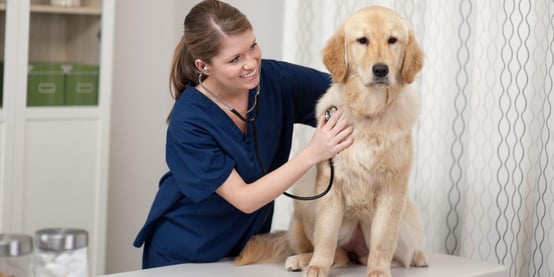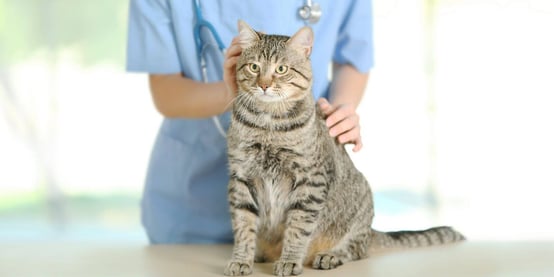Unfortunately, we don’t speak the same language as our dogs and cats! With this language barrier, if we are not paying close attention, we may miss early indicators of medical issues in our pets. If the problem is identified early in the disease process, your veterinarian will have better treatment options, which typically results in better and more successful management of the problem. Waiting to have any of these symptoms evaluated by your veterinarian can potentially have negative outcomes.
Bad Breath
We all know that dogs and cats can have bad breath at times, but did you know this can be a sign of illness in your pet? Periodontal disease is the most common disease seen in our pets. By 2 years of age, 80% of dogs and 70% of cats will show evidence of periodontal disease. Left untreated, periodontal disease can result in painful, loose, and infected teeth. Other consequences can include pathologic fractures, deep bone infections, and an increased prevalence of oral cancers. In addition, periodontal disease has been linked to kidney, liver, and cardiac diseases.
A sudden change in the odour of your dog or cat’s breath can also be observed with intra-oral foreign bodies. Getting plastic sticks between their teeth or having a stick stuck on the roof of their mouth can cause a foul mouth odour.
Other illnesses that aren’t directly related to the oral cavity can also cause a bad odour in your dog or cat's breath. There are some diseases, like diabetes and severe kidney disease that can make your pet’s breath abnormal. In these cases, the bad odour results from a buildup of toxins/chemicals in the bloodstream. For example, in the case of diabetic ketoacidosis, the breath will smell like nail polish remover from the buildup of ketones.
Increased Thirst/Urination
When a dog or cat drinks more water than usual or urines more frequently, this is often an indicator that something is wrong. There are several potential causes of increased thirst and urination, so your veterinarian will likely want to test your pet’s blood and urine to determine the cause.
Some of the more common causes include:
- Kidney Disease
- Bacterial urinary tract infection
- Diabetes
- Addison’s disease
- Cushing's disease
- Elevated calcium level (hypercalcemia)
- Hyperthyroidism (cats)
- High blood pressure
- Liver disease
- Uterine infection (pyometra)
Changes In Appetite
A change in your pet's appetite could signal there is a medical problem. It’s always a good idea to closely monitor your pet’s food intake closely. You should be noticing how much and how quickly they are eating on a daily basis.
There are a few diseases that can increase your pets’ appetite. In cats, this is common in hyperthyroidism. With hyperthyroidism, your cat will have a fantastic appetite but will be losing weight. In dogs, we can see an increase in appetite with Cushing's disease. With this disease, the body is overproducing steroids, which causes an increase in appetite.
If your pet has a decrease in appetite, this can be very concerning. Numerous disease processes can be the cause of a decrease in appetite. We try to break these down into primary and secondary causes. With primary causes, the decrease in appetite is caused by a problem in the gastrointestinal tract (parasites, infection, inflammatory bowel disease, pancreatitis, foreign material, cancer). With secondary causes, the appetite is decreased from a cause that is not originating from the gastrointestinal tract, but rather, elsewhere in the body. Potential secondary causes can include kidney disease, liver disease, pain, and cancer.
New Lumps/Bumps
When we find new lumps or bumps on our pet, it is best to get these evaluated by your veterinarian. We find that the majority of skin and subcutaneous masses in our pets are benign. But unfortunately, we can also find cancer in some of these masses. Some of the more common cancers we can see in skin and subcutaneous masses include mast cell tumours, soft tissue sarcomas, melanoma, lymphoma, and mammary gland tumours.
When you have these lumps evaluated by your veterinarian, they will recommend a fine needle aspirate in order to obtain a cellular sample of the concerning area. They may evaluate these cells in the clinic, or they may send them to a veterinary pathologist in order to establish a diagnosis.
Decrease in Mobility
If your pet is not moving like they used to, this is generally a sign of pain. Unfortunately, our pets can be very subtle in how they show pain, so it is often missed in the early stages.
Osteoarthritis can be very common in cats. By 6 years of age, 60% of cats are affected, and by 12 years of age, 90% of cats are affected. Arthritis is also very common in dogs, with 80% of dogs being affected by the time they are 8 years old. Some examples of mobility changes include:
CATS
- difficulty jumping up or down
- difficulty going up or down stairs
- difficulty running
- difficulty in chasing moving objects
- decrease in grooming behaviour
- changes in litterbox habits
DOGS
- difficulty laying down or getting up
- limping or stiffness
- reluctance to play or jump
- difficulty posturing to urinate or defecate
- muscle mass loss
- reluctance to be touched
If you are noticing any of these changes in your pet, your veterinarian can help develop a treatment plan to reduce your pet’s pain and increase their quality of life.
Weight Loss
If your pet is experiencing unexplained weight loss, this can be a significant cause for concern. Numerous diseases can cause weight loss; some of the more common can include organ dysfunction, metabolic diseases, gastrointestinal disease, cancer, and malnutrition. Your veterinarian will obtain a thorough history, perform a complete physical examination, and recommend diagnostics tests to help determine the cause of your pet’s weight loss.
Hair Coat Changes
When there is a health issue, sometimes we can see changes in your pet’s hair or skin. Metabolic diseases can cause several changes in the hair of dogs. With hypothyroidism, you will likely notice a coarse, brittle hair coat — you will often see breakage of the hair at pressure points, such as the base of the tail. With Cushing's disease, it can be common to see the loss of hair (alopecia) which commonly occurs in a symmetrical pattern on the body.
In cats, having a dull, clumpy hair coat is a sign that your cat is not grooming themselves well. They may not be grooming themselves due to orthopedic pain, oral pain, or generalized weakness from disease.
If we are seeing sores and loss of hair, your pet may be suffering from external parasites (fleas, mites), allergies (contact, environmental, or food-related), or infections (ringworm, bacterial skin infection). These are typically also accompanied by itching or sneezing.
In rarer cases, we can have hair coat changes due to autoimmune diseases. These are diseases where the immune system starts to attack the skin. We can also have cancers that can cause changes to the hair, like cutaneous lymphoma.
Personality Changes
If your pet is showing changes in their personality, they should be evaluated by your veterinarian. A personality change may be the result of a neurologic problem. Your pet may be suffering from an infectious disease that is affecting the brain, an inflammatory condition, or cancer.
Pets can also experience personality changes for several other reasons: joint pain, underlying metabolic disease, and high blood pressure are a few examples. In older pets, we may also see personality changes due to a decrease in their vision and hearing. We also worry about cognitive dysfunction in our senior pets — which is similar to dementia in humans.
Vomiting/Diarrhea
Vomiting and diarrhea are definite causes for concern if noted in your pet. They may be going through a short bout of gastroenteritis that quickly resolves, but if they have symptoms that are recurrent or persistent over 24 hours, it’s best to have your pet evaluated by your veterinarian.
The causes of vomiting and diarrhea can be similar to those that cause a change in appetite, with both primary and secondary causes possible.
One important note in cats is in regard to hairballs. Hairballs should occur less than once a month. If your cat brings up a hairball more than once monthly, this can be a sign of food sensitivity, food allergy, inflammatory bowel disease, or cancer. If this is happening to your cat, I would recommend evaluation by your veterinarian.
Changes in Breathing Patterns
Changes in your pets' breathing patterns can be a huge problem. Some changes that can be seen include an increase in their respiratory rate, an increase in respiratory effort, abdominal pushing when breathing, and wheezing.
These can be signs of respiratory disease (bacterial or fungal infection, the buildup of fluid, heartworm disease, asthma, cancer, etc) and cardiac disease (congestive heart failure), so they should be examined as soon as possible if this is occurring in your pet.
Inappropriate Eliminations
When your pet has historically been well house-trained or litter box trained and you start seeing urinary or fecal accidents in the house, this can be cause for concern.
If your cat is no longer using the litter box, there could be several potential causes. There may be a disease present that is causing your cat to produce more urine (diabetes, kidney disease, and hyperthyroidism). It is also common for older cats with arthritis pain to start having difficulties moving to and in the litter box. Other issues that can develop include bacterial urinary tract infections, bladder stones, and idiopathic cystitis. Cognitive dysfunction can also cause older cats to urinate outside of the litter box.
In our dogs, we can see very similar problems to our feline friends. Mobility issues, diseases that can increase urine production, cognitive dysfunction, bacterial urinary tract infections, and bladder stones can also affect our dogs. A problem that can be unique to dogs is urinary incontinence. Urinary incontinence can happen at any early age; this can be congenital or hormonal in nature. It can also affect your dog in their senior years. Additionally, dogs can be affected by bladder cancer, which does not happen frequently in our cats.



